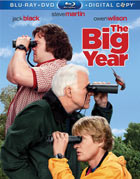BLU-RAY REVIEW

Big Year, The
Featured In Issue 165, March 2012
In The Big Year, Steve Martin, Jack Black, and Owen Wilson portray three amateur bird watchers from very different walks of life, facing a mid-life crisis, a work-life crisis, and a no-life crisis. In the biggest competition of their lives, they undertake an unforgettable trek through North America, to compete to become the ultimate "birder" by spotting the greatest number of species within a single calendar year. Based on the book by Mark Obmascik. (Gary Reber)
Both the theatrical version (01:40:02) and the extended version (01:43:09) are available. Special features include the featurette The Big Migration (HD 18:28), 12 deleted scenes (HD 17:31), a gag reel (HD 05:58), the theatrical trailer, up-front previews, BD-Live functionality, and a digital copy.
The 1080p AVC picture, shot in 33 mm anamorphic Panavision, exhibits a noticeable grain throughout. Still, the imagery is generally sharp, though, some scenes appear to be filtered and thus softly focused. Some slight edge enhancement is noticeable, primarily on verticals such as telephone poles. When sharp, the imagery is impressively revealing of fine detail, especially during close-ups of facial features, hair, clothing, and object texture. The color palette is strongly hued with saturated color that really pops. Fleshtones generally appear natural, though, not always. Contrast is good, with deep blacks, which are at times crushed, and revealing shadow delineation. This is a colorful, pleasing picture and at first look appears stunning but on close examination displays faults. Still the overall impression is colorfully vibrant and won't disappoint. (Gary Reber)
The DTS-HD Master Audio™ 5.1-channel soundtrack is conventionally produced with an overall frontal focus. The music score really opens up the soundfield with a prominent soundstage and surround presence. Atmospherics, in the form of quiet outdoor ambiance, are effective, as well as the occasional sound effect. Deep bass is solid and provides a strong foundation to the soundtrack, especially during the music segments. Dialogue is always intelligible but often wanting in spatial integration. Overall, this is a supportive sonic experience that works well. (Gary Reber)

 then "Add to Home Screen"
then "Add to Home Screen"